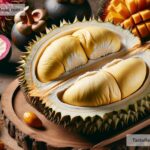The Science Behind the Creamy Texture of Bananas
Bananas are one of the most popular fruits globally. They’re sweet, versatile, and packed with nutrients, but have you ever stopped to think about their texture? That rich, creamy feel in your mouth as you bite into a ripe banana is something many people love. But what makes bananas creamy? Is there science behind it? The answer is yes! In this article, we’ll explore the fascinating reasons why bananas have such a smooth, creamy texture in simple and easy-to-understand language.
The Structure of Bananas: A Peek Inside
To understand the creaminess of bananas, we need to look at their structure. When you open a banana, it might look like a uniform, squishy food, but on a microscopic level, it’s quite complex! Bananas are made up of cells that store water, starch, and sugars. Inside each plant cell is a gel-like substance that contributes to the banana’s softness.
The “creamy” feel of a ripe banana comes from its starch, water content, and how these components break down as the fruit ripens. The key players in this creamy texture are starch molecules, enzymes, and sugar.
Starch: A Big Player in the Journey
If you’ve ever eaten a banana that wasn’t fully ripe, you may have noticed it feels harder and more starchy. That’s because unripe bananas are packed with starch—sometimes as much as 70-80% of the banana’s weight! Starch is a complex carbohydrate made of long chains of glucose (sugar) molecules. It’s not creamy or sweet in its raw form because the chains are tightly packed and rigid.
As bananas ripen, something amazing happens. The green banana starts to turn yellow, and those starch molecules are broken down by enzymes into simpler sugars like glucose, fructose, and sucrose. These sugars don’t just make the banana sweeter; they also change its texture. As the starch breaks down, the rigid structure softens, allowing the banana to take on its creamy, smooth feel.
Enzymes: The Ripening Helpers
Enzymes are special proteins that speed up chemical reactions. In bananas, the most important enzymes involved in ripening are amylase and starch phosphorylase. These enzymes chop up the long starch chains into smaller sugar molecules.
As the enzymes work their magic, bananas undergo a transformation. The stiff and starchy texture you find in green bananas is gradually replaced by something softer and silkier. This process is why ripe bananas feel creamy and soft when you eat them.
It’s not just about texture, though—these enzymes also influence flavor. By breaking down starch into sugars, the enzymes make ripe bananas taste much sweeter than unripe ones.
Water: The Moisture Factor
Water also plays a big role in giving bananas their creamy texture. Bananas naturally contain a high percentage of water—about 75% of their total weight! As the banana ripens, the breakdown of starch and sugars causes the water to become evenly distributed within the fruit. This gives bananas their smooth and moist feel.
The combination of water and sugars creates a gel-like consistency inside the banana cells. This gel contributes to the creamy sensation when you chew it.
Fiber: The Hidden Smoothness
Bananas contain dietary fiber called pectin. Pectin is a type of soluble fiber that gives ripe fruits their soft and jelly-like texture. As a banana ripens, the pectin structure changes, becoming more dispersed and less firm. This change makes the banana even creamier.
Interestingly, pectin is the same substance used to make jams and jellies! In bananas, it helps hold all the water, sugars, and starch together, creating that luscious, melt-in-your-mouth texture.
Why Overripe Bananas Are Extra Creamy
Ever noticed that the more ripe a banana becomes, the creamier and sweeter it feels? When bananas become overripe, the starch breaks down even further, leaving almost no rigid structure at all. At this stage, the banana is mostly sugars and water held together by weakened pectin. This makes overripe bananas extra soft and creamy.
That’s why overripe bananas are perfect for smoothies, banana bread, or desserts—they blend into a smooth texture effortlessly!
The Role of Ripening Temperature
Believe it or not, the temperature at which a banana ripens can also affect its texture. Bananas ripened in warm conditions tend to be softer and creamier compared to those ripened in cooler environments. Warm temperatures speed up the enzymatic activities that break down starch, while cooler temperatures slow the process down. So if you want your bananas to ripen faster for that creamy texture, leave them in a warm spot—not in the fridge!
The Perfect Creamy Banana
To experience the creamiest texture a banana can offer, look for a ripe banana with tiny brown spots on the peel. These spots indicate that the starch has fully converted to sugar, pectin has softened, and the fruit is at its peak. At this stage, a banana will feel velvety smooth and taste deliciously sweet.
Final Thoughts
The creamy texture of bananas is a result of science in action—thanks to the breakdown of starches, the work of enzymes, the presence of water, and the role of fiber like pectin. It’s a wonderful example of how natural processes can turn something starchy and firm into something soft and luscious.
Next time you bite into a ripe banana, take a moment to appreciate the fascinating journey it’s been through. From starch to sugar, from firm to creamy—bananas truly are a scientific wonder packed into a delicious fruit! Enjoy the creaminess, and maybe even use your newfound knowledge to impress your fellow banana lovers!


